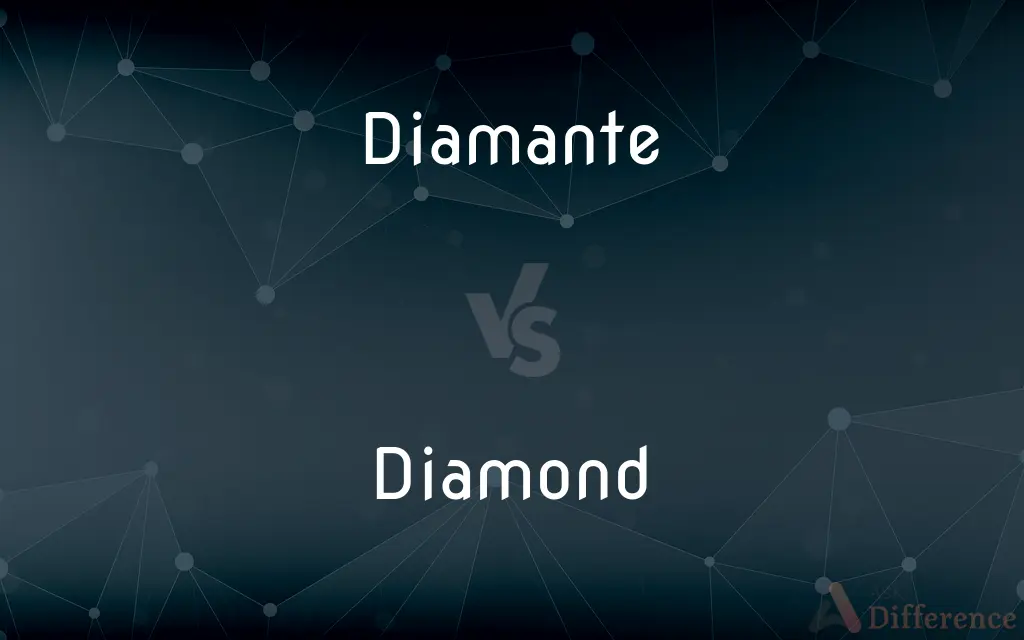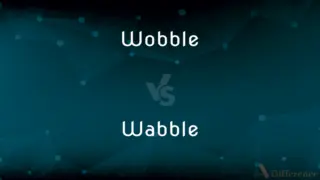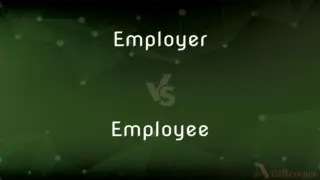Diamante vs. Diamond — What's the Difference?
Edited by Tayyaba Rehman — By Urooj Arif — Updated on April 3, 2024
Diamante refers to glittering decorations or imitation gems, while a diamond is a precious, naturally occurring gemstone.

Difference Between Diamante and Diamond
Table of Contents
ADVERTISEMENT
Key Differences
Diamante, often used in fashion and decoration, signifies items adorned with glittering stones or sequins that mimic the appearance of diamonds. Diamonds, on the other hand, are naturally occurring gemstones formed under high pressure and temperature conditions deep within the Earth's mantle.
While diamante items are valued for their decorative appeal and affordability, providing sparkle and glamour to accessories and clothing, diamonds are prized for their rarity, beauty, and durability, making them highly sought after in jewelry.
The manufacturing process of diamante involves crafting glass, plastic, or synthetic materials to simulate the brilliance of diamonds. Conversely, the creation of a diamond requires geological processes spanning billions of years, followed by meticulous cutting and polishing to reveal its natural brilliance.
Diamantes are versatile in their application, used to embellish a wide range of items from clothing and jewelry to home decor. Diamonds, whereas, are primarily set in jewelry, serving as symbols of luxury, commitment, and status.
Comparison Chart
Definition
Imitation gems used for decoration
Precious gemstones formed under high pressure
ADVERTISEMENT
Material
Glass, plastic, synthetic materials
Carbon
Value Determination
Craftsmanship and decorative appeal
Cut, Color, Clarity, Carat (The Four Cs)
Main Use
Fashion and decorative items
Jewelry
Formation/Creation
Manufactured to mimic diamonds
Natural geological processes
Compare with Definitions
Diamante
Affordable and versatile in application.
Diamante can be used to add glamour to anything from shoes to tableware.
Diamond
Measured by the Four Cs: Cut, Color, Clarity, and Carat.
The diamond's value was high due to its perfect clarity and color.
Diamante
A sparkling decoration or imitation gem.
The dress was adorned with diamante, catching everyone's eye.
Diamond
Requires specialized cutting and polishing to reveal its brilliance.
The diamond cutter expertly faceted the gem to reveal its radiant beauty.
Diamante
Often used in fashion to simulate the look of diamonds.
Her diamante necklace sparkled like real diamonds under the lights.
Diamond
A precious gemstone formed from carbon under high pressure.
The diamond in her ring was brilliantly cut to enhance its sparkle.
Diamante
Valued for their decorative appeal rather than intrinsic worth.
Though not valuable, the diamante brooch was cherished for its beauty.
Diamond
Highly valued for its rarity, durability, and beauty.
Diamonds have been sought after for centuries for their unmatched hardness.
Diamante
Made from various materials including glass and plastic.
The diamante decorations were actually made of finely cut glass.
Diamond
Symbolic of luxury, commitment, and status.
Diamond jewelry is often given to signify love and devotion.
Diamante
A small, glittering ornament, such as a rhinestone or a sequin, applied to fabric or a garment.
Diamond
Diamond is a form of the element carbon with its atoms arranged in a crystal structure called diamond cubic. At room temperature and pressure, another solid form of carbon known as graphite is the chemically stable form of carbon, but diamond almost never converts to it.
Diamante
Fabric that has been covered with many of these ornaments.
Diamond
A precious stone consisting of a clear and colourless crystalline form of pure carbon, the hardest naturally occurring substance
A diamond ring
Diamante
An artificial diamond used as adornment, such as a rhinestone.
Diamond
A figure with four straight sides of equal length forming two opposite acute angles and two opposite obtuse angles; a rhombus
A sweater with a pale-blue diamond pattern
Diamante
A diamante poem.
Diamond
An extremely hard, highly refractive crystalline form of carbon that is usually colorless and is used as a gemstone and in abrasives, cutting tools, and other applications.
Diamante
Covered in diamante decorations
Diamond
A piece of jewelry containing such a gemstone.
Diamante
Shiny or iridescent, as if covered in or made of diamonds
Diamond
A rhombus, particularly when oriented so that one diagonal extends from left to right and the other diagonal extends from top to bottom.
Diamante
Adornment consisting of a small piece of shiny material used to decorate clothing
Diamond
A red, lozenge-shaped figure on certain playing cards.
Diamond
A playing card with this figure.
Diamond
Diamonds (used with a sing. or pl. verb) The suit of cards represented by this figure.
Diamond
The infield.
Diamond
The whole playing field.
Diamond
Of or relating to a 60th or 75th anniversary.
Diamond
To adorn with diamonds.
Diamond
(uncountable) A glimmering glass-like mineral that is an allotrope of carbon in which each atom is surrounded by four others in the form of a tetrahedron. Category:en:Carbon
The saw is coated with diamond.
Diamond
A gemstone made from this mineral.
The dozen loose diamonds sparkled in the light.
Diamond
A ring containing a diamond.
What a beautiful engagement diamond.
Diamond
A very pale blue color.
Diamond
Something that resembles a diamond.
Diamond
(geometry) A rhombus, especially when oriented so that its longer axis is vertical.
Diamond
(geometry) The polyiamond made up of two triangles.
Diamond
(baseball) The entire field of play used in the game.
Diamond
(baseball) The infield of a baseball field.
The teams met on the diamond.
Diamond
(card games) A card of the diamonds suit.
I have only one diamond in my hand.
Diamond
A size of type, standardised as 2 point.
Diamond
The size of type between brilliant and pearl, standardized as 2-point.
Diamond
Made of, or containing diamond, a diamond or diamonds.
He gave her diamond earrings.
Diamond
Of, relating to, or being a sixtieth anniversary.
Today is their diamond wedding anniversary.
Diamond
Of, relating to, or being a seventy-fifth anniversary.
Today is their diamond wedding anniversary.
Diamond
(slang) First-rate; excellent.
He's a diamond geezer.
Diamond
To adorn with or as if with diamonds
Diamond
A precious stone or gem excelling in brilliancy and beautiful play of prismatic colors, and remarkable for extreme hardness.
Diamond
A geometrical figure, consisting of four equal straight lines, and having two of the interior angles acute and two obtuse; a rhombus; a lozenge.
Diamond
One of a suit of playing cards, stamped with the figure of a diamond.
Diamond
A pointed projection, like a four-sided pyramid, used for ornament in lines or groups.
Diamond
The infield; the square space, 90 feet on a side, having the bases at its angles.
Diamond
The smallest kind of type in English printing, except that called brilliant, which is seldom seen.
Diamond
Resembling a diamond; made of, or abounding in, diamonds; as, a diamond chain; a diamond field.
Diamond
A transparent piece of diamond that has been cut and polished and is valued as a precious gem
Diamond
Very hard native crystalline carbon valued as a gem
Diamond
A playing card in the minor suit of diamonds
Diamond
The area of a baseball field that is enclosed by 3 bases and home plate
Diamond
The baseball playing field
Common Curiosities
Can diamantes be used in jewelry?
Yes, diamantes are commonly used in jewelry as affordable alternatives to diamonds, adding sparkle and aesthetic appeal.
Why are diamonds more valuable than diamantes?
Diamonds are highly valued for their rarity, natural beauty, durability, and the intricate process of cutting and polishing them, unlike mass-produced diamantes.
What determines the value of a diamond?
The value of a diamond is determined by the Four Cs: Cut, Color, Clarity, and Carat weight.
What is a diamante?
Diamante refers to imitation diamonds or decorations that mimic the sparkle of real diamonds, often made from glass, plastic, or other synthetic materials.
Where are diamonds found?
Diamonds are found in kimberlite pipes of ancient volcanic eruptions, in countries like South Africa, Russia, and Canada.
Is diamante jewelry durable?
While not as durable as diamond jewelry, high-quality diamante pieces can last a long time with proper care.
Can diamantes scratch glass like diamonds?
No, diamantes do not have the same hardness as diamonds and cannot scratch glass in the same way.
Are diamantes considered precious stones?
No, diamantes are not considered precious stones; they are imitation gems with no intrinsic gemological value.
Can you tell the difference between a diamante and a diamond?
To the untrained eye, it might be difficult, but experts can distinguish them by their physical and optical properties.
Why are diamonds used in engagement rings?
Diamonds symbolize eternal love and commitment, making them a popular choice for engagement rings.
How is a diamond formed?
A diamond is formed deep within the Earth's mantle under extreme pressure and temperature conditions, from carbon atoms.
Do diamantes have any resale value?
Generally, diamantes have minimal resale value compared to diamonds, which can retain or increase in value over time.
Are all diamonds used in jewelry natural?
No, some diamonds used in jewelry are lab-created, offering a more affordable and ethical alternative to natural diamonds.
What are the uses of diamantes?
Diamantes are used to decorate a variety of items, including clothing, accessories, and home decor, adding a touch of glamour.
How are diamonds cut?
Diamonds are cut using specialized tools and techniques to enhance their natural brilliance and maximize their value.
Share Your Discovery

Previous Comparison
Wobble vs. Wabble
Next Comparison
Employer vs. EmployeeAuthor Spotlight
Written by
Urooj ArifUrooj is a skilled content writer at Ask Difference, known for her exceptional ability to simplify complex topics into engaging and informative content. With a passion for research and a flair for clear, concise writing, she consistently delivers articles that resonate with our diverse audience.
Edited by
Tayyaba RehmanTayyaba Rehman is a distinguished writer, currently serving as a primary contributor to askdifference.com. As a researcher in semantics and etymology, Tayyaba's passion for the complexity of languages and their distinctions has found a perfect home on the platform. Tayyaba delves into the intricacies of language, distinguishing between commonly confused words and phrases, thereby providing clarity for readers worldwide.















































